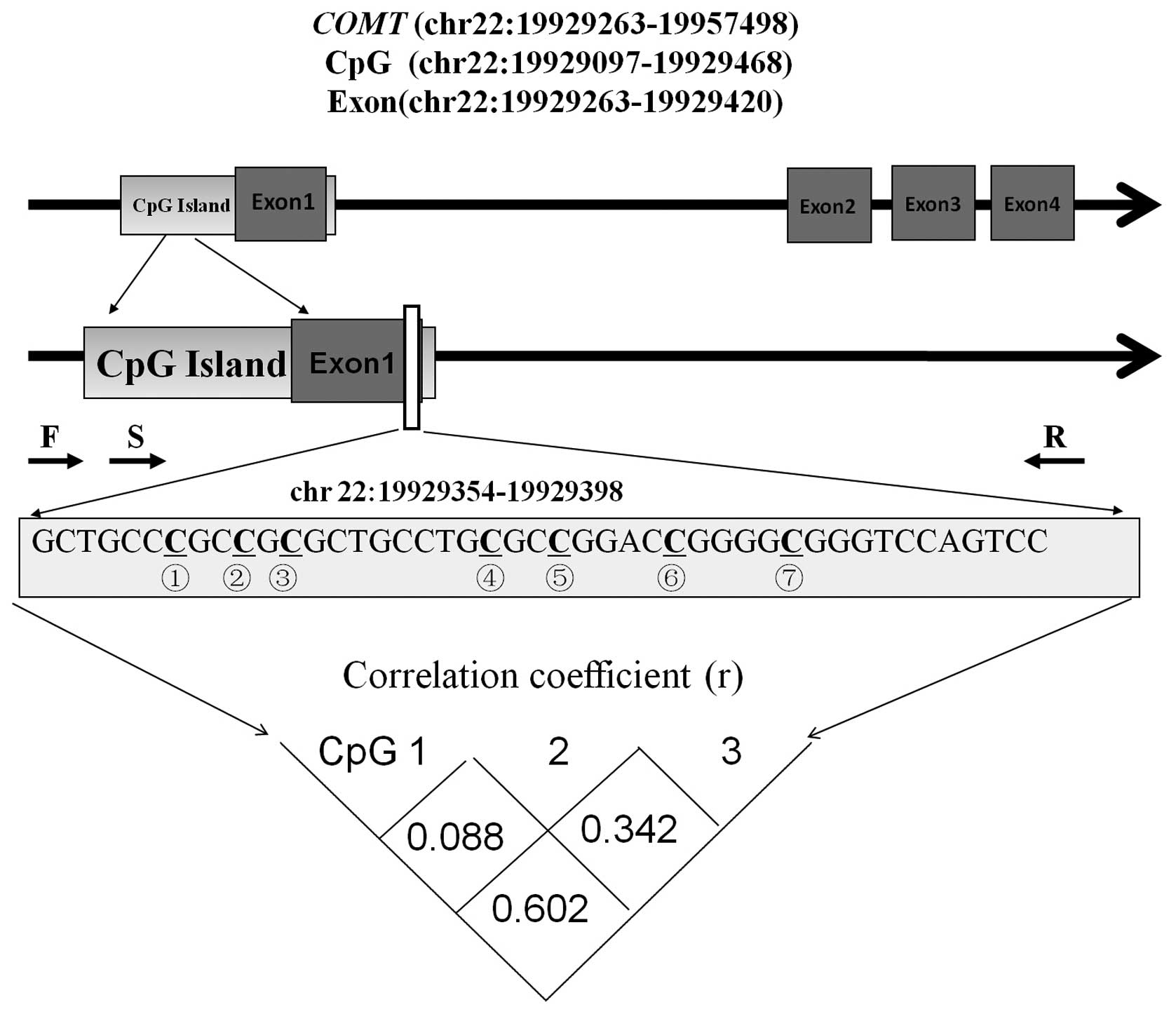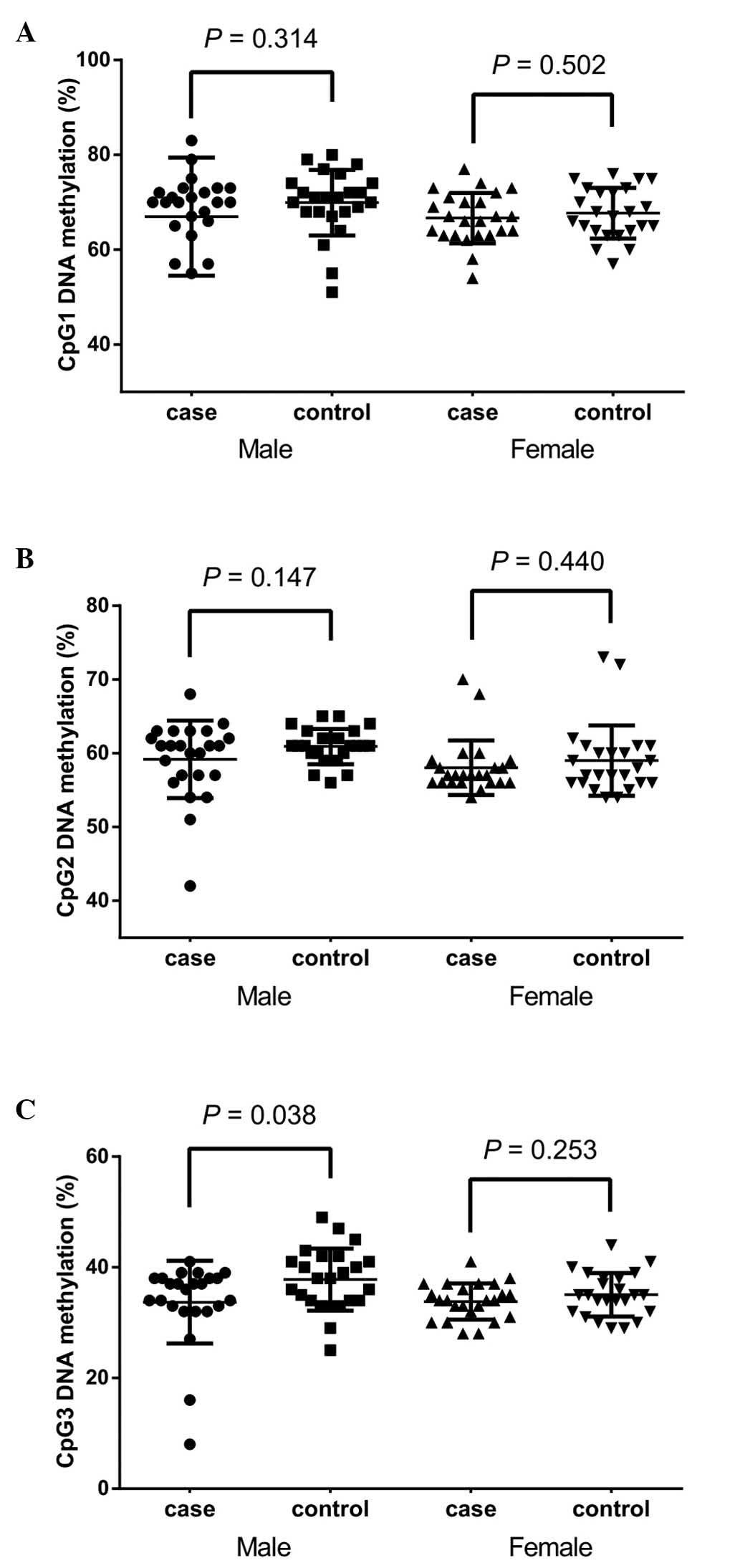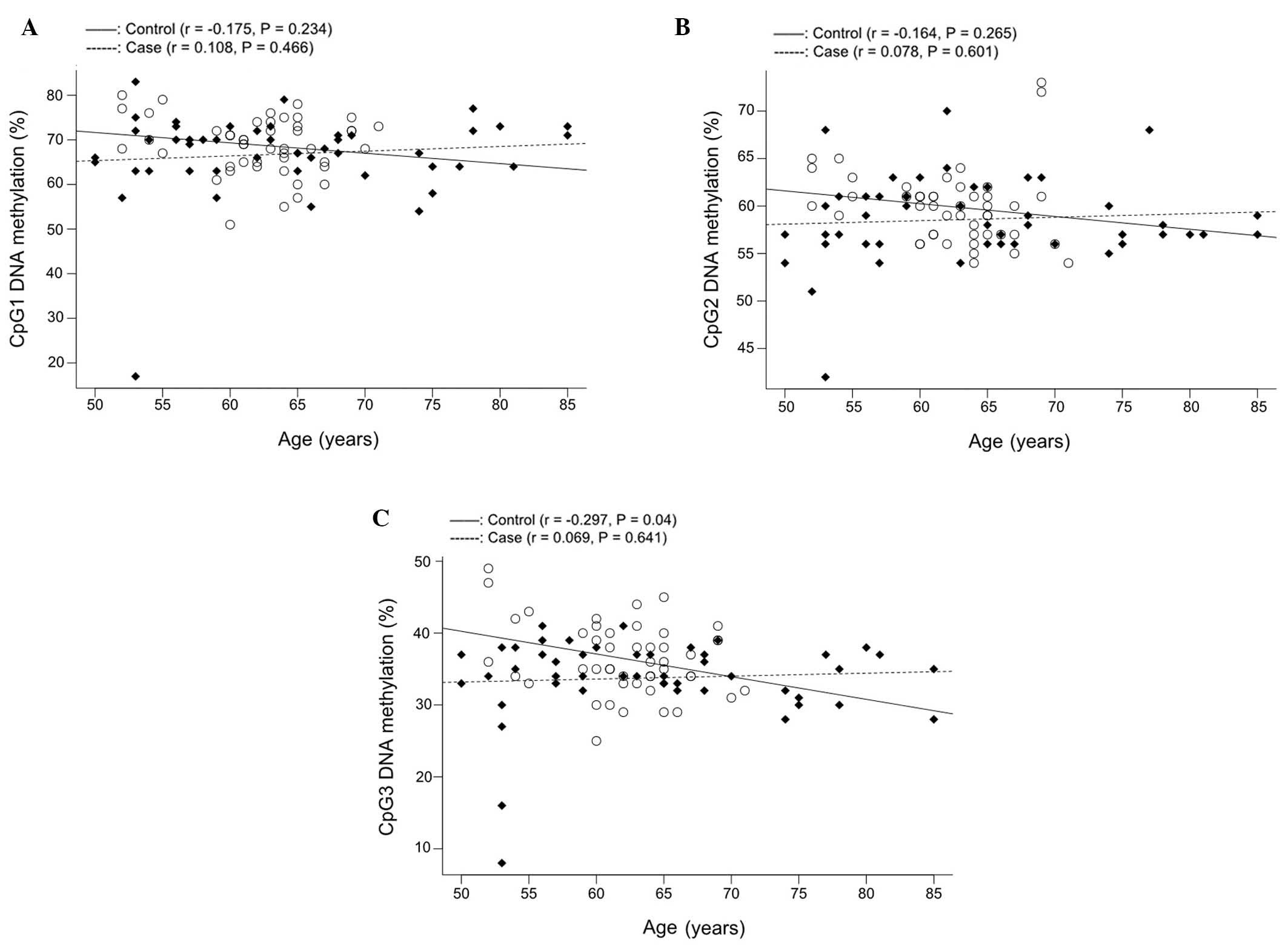Catechol-O-methyltransferase promoter hypomethylation is associated with the risk of coronary heart disease
- Authors:
- Published online on: September 28, 2016 https://doi.org/10.3892/etm.2016.3757
- Pages: 3445-3449
Abstract
Introduction
Coronary heart disease (CHD) is typically caused by arteriosclerosis, which is characterized by the narrowing or blockage of coronary arteries (1). CHD is a complex disease, and a variety of genetic and epigenetic factors have been associated with an increased risk of CHD (2–4). Aberrant methylation of cytosine residues in gene CpG islands is an important molecular mechanism involved in the regulation of gene expression in response to the environment (5). Global DNA hypomethylation has been described in the atherosclerotic human aorta (6). DNA methylation studies on CHD have primarily focused on genes related to estrogen receptors (ESR1 and ESR2), the immune system (FOXP3, PLA2G7 and MMP-9), lipid metabolism (ABCA1, KLF2 and LRP1), oxidative stress (GSTP1, BNIP3 and EC-COD), blood coagulation (TM and P2Y12) and genes on chromosome 9p21 (BAX, BCL-2 and TIMP3) (7). In addition, low promoter methylation was found to account for increased expression of the 15-lipoxygenase (ALOX15) gene (8). Furthermore, coagulation factor VII (F7) promoter hypomethylation has been correlated with higher plasma expression levels of activated coagulation factor VII (FVIIa), and has been shown to contribute towards an increased risk of CHD (9).
The catechol-O-methyltransferase (COMT) gene, located on chromosome 22q 11.21, encodes a regulatory enzyme, catecholamine and other catechols (10,11). COMT is able to transfer a methyl group to degrade dopamine, catecholamine, epinephrine and norepinephrine (12). In addition, COMT is associated with numerous human disorders, such as schizophrenia and bipolar disorder (13,14). Furthermore, a number of studies have revealed an association between COMT and metabolic syndromes, such as hypertension and diabetes, that are closely associated with CHD (15,16). COMT gene variation serves an important role in the increased risk of acute coronary events (17).
Hypomethylation of the COMT promoter has been detected in patients with schizophrenia and bipolar disorder (13,18). However, it is unknown whether methylation of the COMT promoter contributes towards the risk of CHD. In light of previous findings, the aim of the current study was to assess the association between COMT gene promoter methylation and the risk of CHD.
Materials and methods
Sample selection
In total, 48 cases of CHD (24 males and 24 females) and 48 gender-matched non-CHD controls from a Han Chinese population were selected from Ningbo First Hospital of Ningbo University (Ningbo, China). The mean ages of the CHD cases and non-CHD controls were 64.0 years (range, 50.0–85.0 years) and 62.2 years (range, 52.0–71.0 years), respectively. Unrelated individuals were examined by coronary angiography and diagnosed by experienced cardiologists. The classification details and inclusion criteria were as previously described (19–21). Peripheral blood samples were collected between June 2013 and June 2014. The current case-control study was approved by the Ethics Committee of Ningbo First Hospital. Written informed consent was obtained from each of the participants.
DNA methylation assay
Genomic DNA was collected from peripheral blood samples using a nucleic acid extraction automatic analyzer (Lab-Aid 820; Zeesan Biotech Co., Ltd., Xiamen, China). DNA was quantified using a PicoGreen double-stranded DNA Quantification kit (Molecular Probes; Thermo Fisher Scientific, Inc., Waltham, MA, USA) according to the manufacturer's protocol. Pyrosequencing using PyroMark Gold Q24 Reagent (Qiagen, Hilden, Germany) was conducted to identify the methylation level of the promoter region of the COMT gene. Sodium bisulfite was used as a chemical modifier of genomic DNA to convert unmethylated cytosine to uracil. Polymerase chain reaction (Pyromark PCR kit; Qiagen) was performed using a mixture of primers designed using PyroMark Assay Design software, version 2.0 (Qiagen) yielding a fragment of COMT gene promoter (103 bp). The PCR reaction mixtures contained 10 µl ZymoTaq™ Premix (Zymo Research Corporation, Irvine, CA, USA), 2 µl DNA template, 1.5 µl each primer and 5 µl DNase/RNase-free water. PCR amplification was conducted under the following conditions: 95°C for 10 min, followed by 45 cycles of 95°C for 20 sec, 57.5°C for 20 sec and 72°C for 30 sec The primer sequences used were: Forward, 5′-GGGTTTTTGGGGTAGTTAG-3′; reverse, 5′-biotin-TAACCAACCCTCTCACCT-3′; and 5′-TTTGGGGTAGTTAGG-3′ for the sequencing primer. The methylation rate of each CG site was quantified and analyzed using the PyroMark Assay Design software.
Statistical analysis
Statistical tests were analyzed using SPSS version 16.0 (SPSS, Inc., Chicago, IL, USA). An independent sample t-test was applied to identify COMT methylation differences between CHD cases and controls. A non-parametric approach was used for data that could not be normalized. P<0.05 was considered to indicate a statistically significant difference. The figures were created using GraphPad Prism version 6 software (GraphPad Software, Inc., La Jolla, CA, USA) or R software (version 3.1; https://www.r-project.org/).
Results
Correlation between the DNA methylation levels of the three CpG sites
As shown in Fig. 1, seven CpG sites were identified in the selected fragment (chr22:19929354-19929398, Human GRCh37/hg19 Assembly) of the promoter region of the COMT gene. However, due to sequencing limitations, reliable methylation results were only available for the three CpG sites preceding the fragment and, thus, these three sites were chosen to represent promoter methylation of the COMT gene. The results demonstrated that there was a moderate correlation between the DNA methylation levels of the three CpG sites (Fig. 1). Therefore, the three CpG sites were tested separately in the subsequent association analyses.
Comparison of the methylation levels of the three CpG sites in CHD
The follow-up case-control comparison showed that there was a significantly lower level of CpG3 methylation in CHD cases compared with non-CHD controls (Fig. 2; 33.77±5.71 vs. 36.42±5.00%; P=0.018). However, no significant difference in the methylation level was found between the cases and controls in CpG1 (Fig. 2; P=0.224) and CpG2 (Fig. 2, P=0.118). Further subgroup analysis by gender (Fig. 3) suggested that the significant association between CpG3 methylation was retained in males (Fig. 3C; 33.71±7.49 vs. 37.79±5.61%; P=0.038) but not in females (Fig. 3C; P=0.253) at the CpG3 site.
Correlation between COMT and the three CpG sites
Further correlation tests (Fig. 4) demonstrated that COMT CpG3 methylation was associated with age in controls (Fig. 4C; r=−0.297, P=0.040) but not in CHD cases. However, gender-stratified analysis in the control group did not identify any significant association between males (P=0.072, data not shown) or females (P=0.300, data not shown). Therefore, additional studies are required to confirm this inverse correlation in the non-CHD controls.
Discussion
Findings of the current study demonstrated that CHD cases have lower levels of methylated COMT CpG3 compared with the controls. Further breakdown analysis by gender showed that CpG3 methylation was significantly associated with CHD in males (P=0.038) but not in females (P=0.253), suggesting a gender disparity in the association between COMT methylation and CHD. Additionally, the COMT CpG3 methylation level was inversely associated with age in the controls but not in cases with CHD.
COMT encodes a methyltransferase that demethylates s-adenosylmethionine to S-adenosyl-L-homocysteine, the immediate precursor of homocysteine (22). Therefore, COMT, as a homocysteine metabolism-mediated gene, has been hypothesized to serve a vital role in the increased risk of CHD (17). A low activity COMT genotype has a protective effect against cardiovascular diseases (23). The results in the present study show significant promoter hypomethylation of COMT among CHD cases, indicating a potential biomarker for predicting the occurrence and development of CHD.
Gender disparity exists in the pathogenesis of CHD (24). The current study identified a significant difference in the association between CpG3 methylation and CHD with regards to males and females. However, as there is no evidence suggesting that COMT serves an important role in the metabolism of estrogen, further studies are required to determine whether COMT interacts with other proteins associated with the metabolism of estrogen (25).
Altered DNA methylation patterns are one of the molecular mechanisms that underlie the phenotypic changes associated with human aging (26). In the present study, it was observed that COMT CpG3 methylation levels was reduced with increasing age in controls. It can, therefore, be hypothesized that COMT hypermethylation serves an important protective role against cardiovascular diseases, although the exact mechanisms underlying this role need to be investigated in future studies.
The current study had a number of limitations. Firstly, the sample size in the present study was relatively small. Larger sample sizes and the inclusion of other ethnic populations are required in order to confirm the findings. Secondly, COMT methylation was measured in the DNA of the peripheral blood, which included numerous types of cells, such as granulocytes and lymphocytes, which potentially affect the specificity of the methylation assay, as COMT methylation levels may vary between cell types. Thirdly, only three CpG sites from a fragment of the gene promoter region were selected to represent the entire COMT promoter. Although the cases with CHD were gender matched with the controls, the potential effects of other unknown environmental factors on the findings regarding COMT methylation cannot be excluded.
In conclusion, it was observed that COMT promoter hypomethylation is associated with CHD in males. The results contribute towards a better understanding of the role of COMT methylation in the pathophysiology of CHD.
Acknowledgements
The present study was supported by the grants from the National Natural Science Foundation of China (grant nos. 31100919 and 81371469), the Natural Science Foundation of Zhejiang Province (grant no. LR13H020003) and the K.C. Wong Magna Fund from Ningbo University.
References
|
Jia X, Li W, Miao Z, Feng C, Liu Z, He Y, Lv J, Du Y, Hou M, He W, et al: Identification of modules related to programmed cell death in CHD based on EHEN. BioMed Res Int. 2014:4753792014. View Article : Google Scholar : PubMed/NCBI | |
|
Ding H, yan F, Zhou LL, Ji XH, Gu XN, Tang ZW and Chen RH: Association between previously identified loci affecting telomere length and coronary heart disease (CHD) in Han Chinese population. Clin Interv Aging. 9:857–861. 2014.PubMed/NCBI | |
|
Evans A, Van Baal GCM, McCarron P, DeLange M, Soerensen TI, De Geus EJ, Kyvik K, Pedersen NL, Spector TD, Andrew T, et al: The genetics of coronary heart disease: The contribution of twin studies. Twin Res. 6:432–441. 2003. View Article : Google Scholar : PubMed/NCBI | |
|
Kelpis TG, Anastasiadis K, Nimatoudis I, Kelpi MG, Hadjimiltiades S and Papakonstantinou C: Prevalence of ‘distressed’ personality in patients with coronary artery disease and its correlation with morbidity after coronary surgery. Hellenic J Cardiol. 54:362–367. 2013.PubMed/NCBI | |
|
Tang L, Ye H, Hong Q, Wang L, Wang Q, Wang H, Xu L, Bu S, Zhang L, Cheng J, et al: Elevated CpG island methylation of GCK gene predicts the risk of type 2 diabetes in Chinese males. Gene. 547:329–333. 2014. View Article : Google Scholar : PubMed/NCBI | |
|
Yamada Y, Nishida T, Horibe H, Oguri M, Kato K and Sawabe M: Identification of hypo- and hypermethylated genes related to atherosclerosis by a genome-wide analysis of DNA methylation. Int J Mol Med. 33:1355–1363. 2014.PubMed/NCBI | |
|
Ye H, Hong Q, Tang L, Zhou A, Jiang D, Li Y, Dai D and Duan S: DNA methylation in coronary heart disease. Xi Bao Sheng Wu Xue Za Zhi. 36:1422–1429. 2014.(In Chinese). | |
|
Hiltunen MO, Tuomisto TT, Niemi M, Bräsen JH, Rissanen TT, Törönen P, Vajanto I and Ylä-Herttuala S: Changes in gene expression in atherosclerotic plaques analyzed using DNA array. Atherosclerosis. 165:23–32. 2002. View Article : Google Scholar : PubMed/NCBI | |
|
Friso S, Lotto V, Choi SW, Girelli D, Pinotti M, Guarini P, Udali S, Pattini P, Pizzolo F, Martinelli N, et al: Promoter methylation in coagulation F7 gene influences plasma FVII concentrations and relates to coronary artery disease. J Med Genet. 49:192–199. 2012. View Article : Google Scholar : PubMed/NCBI | |
|
Männistö PT and Kaakkola S: Catechol-O-methyltransferase (COMT): Biochemistry, molecular biology, pharmacology and clinical efficacy of the new selective COMT inhibitors. Pharmacol Rev. 51:593–628. 1999.PubMed/NCBI | |
|
Wardle MC, de Wit H, Penton-Voak I, Lewis G and Munafò MR: Lack of association between COMT and working memory in a population-based cohort of healthy young adults. Neuropsychopharmacolgy. 38:1253–1263. 2013. View Article : Google Scholar | |
|
Baud P, Courtet P, Perroud N, Jollant F, Buresi C and Malafosse A: Catechol-O-methyltransferase polymorphism (COMT) in suicide attempters: A possible gender effect on anger traits. Am J Med Genet B Neuropsychiatr Genet 144B. 1042–1047. 2007. View Article : Google Scholar | |
|
Abdolmaleky HM, Cheng KH, Faraone SV, Wilcox M, Glatt SJ, Gao F, Smith CL, Shafa R, Aeali B, Carnevale J, et al: Hypomethylation of MB-COMT promoter is a major risk factor for schizophrenia and bipolar disorder. Hum Mol Genet. 15:3132–3145. 2006. View Article : Google Scholar : PubMed/NCBI | |
|
Bosia M, Pigoni A, Pirovano A, Lorenzi C, Spangaro M, Buonocore M, Bechi M, Cocchi F, Guglielmino C, Bramanti P, et al: COMT and STH polymorphisms interaction on cognition in schizophrenia. Neurol Sci. 36:215–220. 2015. View Article : Google Scholar : PubMed/NCBI | |
|
Kring SI, Werge T, Holst C, Toubro S, Astrup A, Hansen T, Pedersen O and Sørensen TI: Polymorphisms of serotonin receptor 2A and 2C genes and COMT in relation to obesity and type 2 diabetes. PloS One. 4:e66962009. View Article : Google Scholar : PubMed/NCBI | |
|
Hagen K, Pettersen E, Stovner LJ, Skorpen F, Holmen J and Zwart JA: High systolic blood pressure is associated with Val/Val genotype in the catechol-O-methyltransferase gene. The nord-trøndelag health study (HUNT). Am J Hypertens. 20:21–26. 2007. View Article : Google Scholar : PubMed/NCBI | |
|
Voutilainen S, Tuomainen TP, Korhonen M, Mursu J, Virtanen JK, Happonen P, Alfthan G, Erlund I, North KE, Mosher MJ, et al: Functional COMT Val158Met polymorphism, risk of acute coronary events and serum homocysteine: The kuopio ischaemic heart disease risk factor study. PloS One. 2:e1812007. View Article : Google Scholar : PubMed/NCBI | |
|
Nohesara S, Ghadirivasfi M, Mostafavi S, Eskandari MR, Ahmadkhaniha H, Thiagalingam S and Abdolmaleky HM: DNA hypomethylation of MB-COMT promoter in the DNA derived from saliva in schizophrenia and bipolar disorder. J Psychiatr Res. 45:1432–1438. 2011. View Article : Google Scholar : PubMed/NCBI | |
|
Jiang D, Zheng D, Wang L, Huang Y, Liu H, Xu L, Liao Q, Liu P, Shi X, Wang Z, et al: Elevated PLA2G7 gene promoter methylation as a gender-specific marker of aging increases the risk of coronary heart disease in females. PloS One. 8:e597522013. View Article : Google Scholar : PubMed/NCBI | |
|
Zhou J, Huang Y, Huang RS, Wang F, Xu L, Le Y, Yang X, Xu W, Huang X, Lian J and Duan S: A case-control study provides evidence of association for a common SNP rs974819 in PDGFD to coronary heart disease and suggests a sex-dependent effect. Thromb Res. 130:602–606. 2012. View Article : Google Scholar : PubMed/NCBI | |
|
Ye H, Zhao Q, Huang Y, Wang L, Liu H, Wang C, Dai D, Xu L, Ye M and Duan S: Meta-analysis of low density lipoprotein receptor (LDLR) rs2228671 polymorphism and coronary heart disease. BioMed Res Int. 2014:5649402014. View Article : Google Scholar : PubMed/NCBI | |
|
Müller T: Catechol-O-methyltransferase inhibitors in Parkinson's disease. Drugs. 75:157–174. 2015. View Article : Google Scholar : PubMed/NCBI | |
|
Eriksson AL, Skrtic S, Niklason A, Hultén LM, Wiklund O, Hedner T and Ohlsson C: Association between the low activity genotype of catechol-O-methyltransferase and myocardial infarction in a hypertensive population. Eur Heart J. 25:386–391. 2004. View Article : Google Scholar : PubMed/NCBI | |
|
Hyvärinen M, Qiao Q, Tuomilehto J, Söderberg S, Eliasson M and Stehouwer CDA: The difference between acute coronary heart disease and ischaemic stroke risk with regard to gender and age in Finnish and Swedish populations. Int J Stroke. 5:152–156. 2010. View Article : Google Scholar : PubMed/NCBI | |
|
Martorell L, Costas J, Valero J, Gutierrez-Zotes A, Phillips C, Torres M, Brunet A, Garrido G, Carracedo A, Guillamat R, et al: Analyses of variants located in estrogen metabolism genes (ESR1, ESR2, COMT and APOE) and schizophrenia. Schizophr Res. 100:308–315. 2008. View Article : Google Scholar : PubMed/NCBI | |
|
Raddatz G, Hagemann S, Aran D, Söhle J, Kulkarni PP, Kaderali L, Hellman A, Winnefeld M and Lyko F: Aging is associated with highly defined epigenetic changes in the human epidermis. Epigenetics Chromatin. 6:362013. View Article : Google Scholar : PubMed/NCBI |














